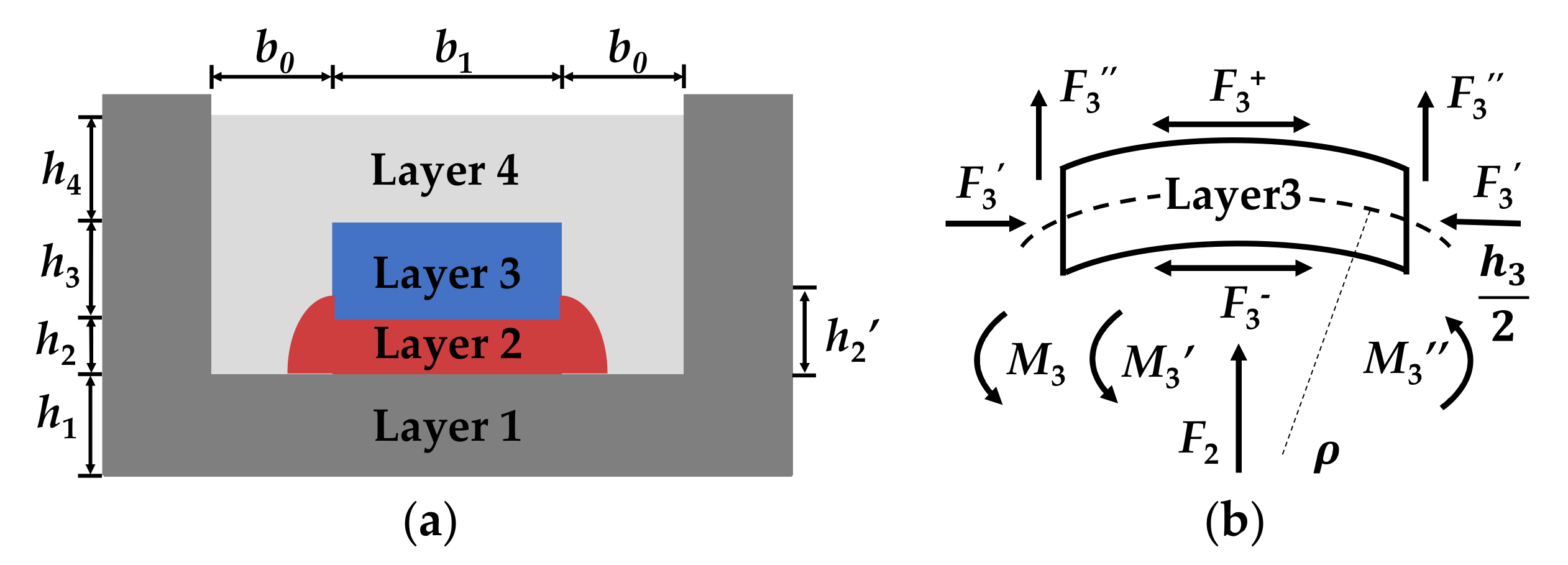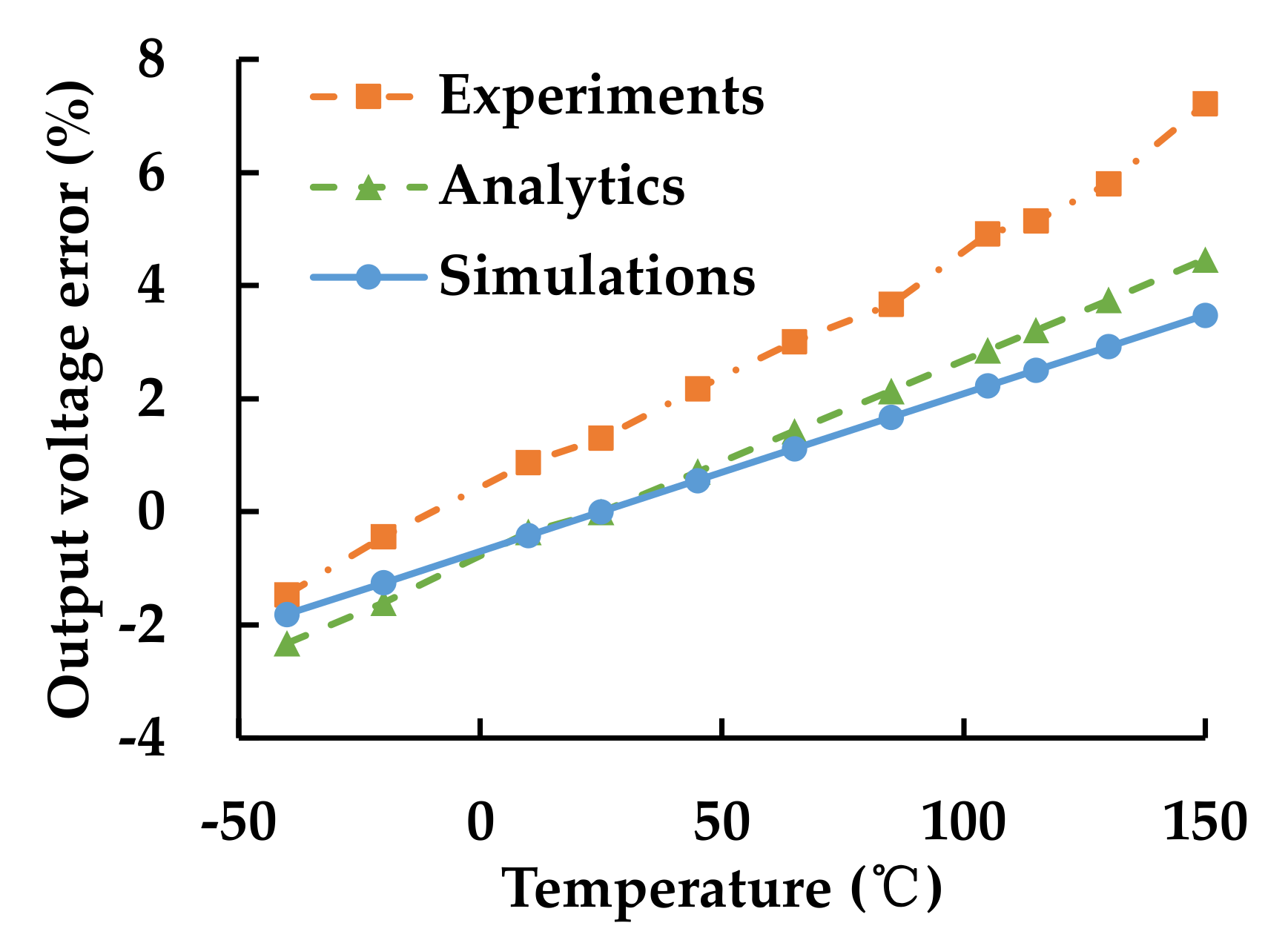Investigation of Potting-Adhesive-Induced Thermal Stress in MEMS Pressure Sensor
Abstract
1. Introduction
2. Experimental Investigation
3. Analytic Analysis
4. Numerical Simulation
4.1. Geometric Model
4.2. Finite Element Model
4.3. Finite Element Simulation
5. Conclusions
Author Contributions
Funding
Conflicts of Interest
References
- Prosenjit, R. MEMS and MOEMS Technology and Applications; SPIE: Bellingham, WA, USA, 2000; ISBN 9780819495983. [Google Scholar]
- Cibula, E.; Ðonlagić, D. Miniature fiber-optic pressure sensor with a polymer diaphragm. Appl. Optics. 2005, 44, 2736–2744. [Google Scholar] [CrossRef] [PubMed]
- Ge, G.; Zhang, Y.; Shao, J.; Wang, W.; Si, W.; Huang, W.; Dong, X. Stretchable, transparent, and self-patterned hydrogel-based pressure sensor for human motions detection. Adv. Funct. Mater. 2018, 28, 1802576. [Google Scholar] [CrossRef]
- Lee, T.H.; Kim, E.S.; Kim, T.H.; Jeong, M.Y. Simple pressure sensor for a vehicle seat using a woven polymer optical-fiber sheet. J. Korean Phys. Soc. 2015, 67, 1947–1951. [Google Scholar] [CrossRef]
- Zhang, M.; Du, L.; Zhao, Z.; Fang, Z. Low-stress packaging for a MEMS atmosphere pressure sensor. In Proceedings of the IEEE International Conference on Nano/Micro Engineered & Molecular Systems, Suzhou, China, 7–10 April 2013. [Google Scholar]
- Li, C.; Cordovilla, F.; Ocaa, J. Design optimization and fabrication of a novel structural piezoresistive pressure sensor for micro-pressure measurement. Solid State Electron. 2018, 139, 39–47. [Google Scholar] [CrossRef]
- Wang, T.; Tang, Z.; Lin, H.; Zhan, K.; Wan, J.; Wu, S.; Gu, Y.; Luo, W.; Zhang, W. A low temperature drifting acoustic wave pressure sensor with an integrated vacuum cavity for absolute pressure sensing. Sensors 2020, 20, 1788. [Google Scholar] [CrossRef] [PubMed]
- Tran, A.; Zhang, X.; Zhu, B. Mechanical structural design of a piezoresistive pressure sensor for low-pressure measurement: A computational analysis by increases in the sensor sensitivity. Sensors 2018, 18, 2023. [Google Scholar] [CrossRef] [PubMed]
- Krondorfer, R.; Kim, Y.K.; Kim, J.; Gustafson, C.G.; Lommasson, T.C. Finite element simulation of package stress in transfer molded MEMS pressure sensors. Microelectron. Reliab. 2004, 44, 1995–2002. [Google Scholar] [CrossRef]
- Marina, S.; Dubravka, R.; Sreco, M. Residual stresses in a pressure-sensor package induced by adhesive material during curing: A case study-ScienceDirect. Sens. Actuators A Phys. 2004, 116, 442–449. [Google Scholar]
- Wu, B.; Kim, D.S.; Han, B.; Palczynska, A.; Gromala, P.J. Thermal deformation analysis of automotive electronic control units subjected to passive and active thermal conditions. In Proceedings of the 16th International Conference on Thermal, Mechanical and Multi-Physics Simulation and Experiments in Microelectronics and Microsystems, Budapest, Hungary, 19–22 April 2015; IEEE: Piscataway, NJ, USA, 2015; pp. 1–6. [Google Scholar]
- Zhang, Y.; Li, H.; Shen, S.; Zhang, G.; Yang, Y.; Liu, Z.; Xie, Q.; Gao, C.; Zhang, P.; Zhao, W. Investigation of acoustic injection on the MPU6050 accelerometer. Sensors 2019, 19, 3083. [Google Scholar] [CrossRef] [PubMed]
- Tran, A.; Zhang, X.; Zhu, B. Effects of temperature and residual stresses on the output characteristics of a piezoresistive pressure sensor. IEEE Access. 2019, 7, 27668–27676. [Google Scholar] [CrossRef]
- Chiou, J.; Chen, S. Thermal hysteresis analysis of MEMS pressure sensors. ASME Int. Mech. Eng. Congr. Expo. 2004, 47071, 281–288. [Google Scholar]
- Lu, C.; Yeh, M. Thermal stress analysis of chip with pressure sensor embedded in accelerometer. In Proceedings of the 2017 International Conference on Electronics Packaging (ICEP), Yamagata, Japan, 19–22 April 2017; IEEE: Piscataway, NJ, USA, 2017; pp. 540–543. [Google Scholar]
- Song, X.; Liu, S. A performance prediction model for a piezoresistive transducer pressure sensor. In Proceedings of the Fifth International Conference on Electronic Packaging Technology Proceedings, Shanghai, China, 28–30 October 2003; IEEE: Piscataway, NJ, USA, 2003; pp. 30–35. [Google Scholar]
- Subbiah, N.; Feng, Q.; Wilde, J.; Bruckner, G. High-temperature pressure sensor package and characterization of thermal stress in the assembly up to 500 °C. In Proceedings of the Electronic Components and Technology Conference (ECTC), Las Vegas, NV, USA, 28–31 May 2019; IEEE: Piscataway, NJ, USA, 2019; pp. 878–883. [Google Scholar]
- Zhang, Z.; Wan, Z.; Liu, C.; Cao, G.; Lu, Y.; Liu, S. Effects of adhesive material on the output characteristics of pressure sensor. In Proceedings of the International Conference on Electronic Packaging Technology & High Density Packaging, Xi’an, China, 16–19 August 2010; IEEE: Piscataway, NJ, USA, 2010; pp. 657–660. [Google Scholar]
- Chou, T.L.; Chu, C.H.; Lin, C.T.; Chiang, K.N. Sensitivity analysis of packaging effect of silicon-based piezoresistive pressure sensor. Sens. Actuators A Phys. 2009, 152, 29–38. [Google Scholar] [CrossRef]
- Dörfler, A.; Feiertag, G.; Schmidt, M.; Ruediger, A.; Wagner, U. Numerical optimization of thermally induced hysteresis effects in the packaging of MEMS pressure sensors. IEEE Sens. J. 2019, 19, 3633–3639. [Google Scholar] [CrossRef]
- Strain Calculation in MEMS; Wuhan FineMEMS Inc.: Wuhan, China, 2018.
- Uses. Available online: https://www.britannica.com/science/silicon/Uses (accessed on 11 March 2021).
- Physical Properties of Potting Materials for Pressure Sensor; Wuhan FineMEMS Inc.: Wuhan, China, 2017.
- Physical Properties of Bonding Adhesive for Pressure Sensor; Wuhan FineMEMS Inc.: Wuhan, China, 2016.
- Alumina—Aluminium Oxide—Al2O3—A Refractory Ceramic Oxide. Available online: https://www.azom.com/properties.aspx?ArticleID=52 (accessed on 11 March 2021).













| Structure | Materials | Property (Unit) | Value | Reference |
|---|---|---|---|---|
| MEMS | Silicon | CTE (1/K) | 2.6 × 10−6 | [22] |
| E (GPa) | 170 | [22] | ||
| μ | 0.28 | [22] | ||
| ρ (kg/m3) | 2329 | [22] | ||
| Potting adhesive | Epoxy resin 1 | CTE (1/K) | (14.9~23.0) × 10−6 | [23] |
| E (GPa) | 1.30~1.75 | [23] | ||
| μ | 0.3 | [23] | ||
| ρ (kg/m3) | 2000 | [23] | ||
| Bonding adhesive | Epoxy resin 2 | CTE (1/K) | (26~40) × 10−6 | [24] |
| E (GPa) | 2.2~3.5 | [24] | ||
| μ | 0.3 | [24] | ||
| ρ (kg/m3) | 1700 | [24] | ||
| Shield ring | Al2O3 | CTE (1/K) E (GPa) μ ρ (kg/m3) | 6.5 × 10−6 400 0.22 3965 | [25] [25] [25] [25] |
| Substrate |
Publisher’s Note: MDPI stays neutral with regard to jurisdictional claims in published maps and institutional affiliations. |
© 2021 by the authors. Licensee MDPI, Basel, Switzerland. This article is an open access article distributed under the terms and conditions of the Creative Commons Attribution (CC BY) license (http://creativecommons.org/licenses/by/4.0/).
Share and Cite
Zhang, Y.; Li, B.; Li, H.; Shen, S.; Li, F.; Ni, W.; Cao, W. Investigation of Potting-Adhesive-Induced Thermal Stress in MEMS Pressure Sensor. Sensors 2021, 21, 2011. https://doi.org/10.3390/s21062011
Zhang Y, Li B, Li H, Shen S, Li F, Ni W, Cao W. Investigation of Potting-Adhesive-Induced Thermal Stress in MEMS Pressure Sensor. Sensors. 2021; 21(6):2011. https://doi.org/10.3390/s21062011
Chicago/Turabian StyleZhang, Yunfan, Bowen Li, Hui Li, Shengnan Shen, Feng Li, Wentao Ni, and Wan Cao. 2021. "Investigation of Potting-Adhesive-Induced Thermal Stress in MEMS Pressure Sensor" Sensors 21, no. 6: 2011. https://doi.org/10.3390/s21062011
APA StyleZhang, Y., Li, B., Li, H., Shen, S., Li, F., Ni, W., & Cao, W. (2021). Investigation of Potting-Adhesive-Induced Thermal Stress in MEMS Pressure Sensor. Sensors, 21(6), 2011. https://doi.org/10.3390/s21062011






